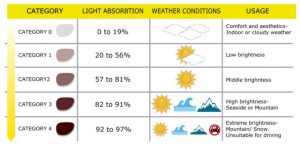
Did you know that UV radiation can cause cataracts? Sunglasses are a common fashion accessory, but first of all, we should not forget their primary meaning and basic function: to protect us and our eyes from the harmful rays of the sun. The overall quality of the sunglasses is made up of the UV filter, shape and color of the lenses. How to choose the right ones?
Many of us have the impression that the darker the glass, the higher the protection against sunlight. However, this notion may not always reflect that it is so. It is not enough to focus on the darkness of the glasses, but also on the value of the UV filter. Dark colors of sunglass lenses that do not have an adequate UV filter cause the cornea to expand, allowing more harmful UV radiation to enter the eye. And even more so than if you didn’t have glasses at all.
What does tinting of glasses mean?
The directives of the European Union determine the categories of five degrees of tinting of glasses. These include information about the intensity of the color of the filter, the weather conditions in which the glasses are suitable for wearing and finally their use itself. The first two categories (0 and 1) are considered fashion glasses, categories 2 and 3 already fall under sunglasses, and category 4 are special sunglasses, with which it is not recommended to drive, for example.
- Category 0 provides the weakest protection. The filter is colorless or very lightly colored and is commonly used in the case of sports or safety glasses. The main role of these glasses is protection against wind, dust or small debris. With up to 20% tinting, glasses with this filter are not suitable for sun protection.
-

Source: https://matheson-optometrists.com/sunglasses/Sunglasses.html For days when it is mostly cloudy, glasses with a category 1 filter can be used. The lenses are very weakly tinted, usually yellow or orange, they can protect against weaker sunlight or serve as protection against wind or dust.
- In category 2, the tinting intensity is up to 57-81% and these glasses already belong to the sun family. The medium-dark filter is suitable for protection against moderate intensity of sunlight and for normal wear. With this filter, you will not have a problem when driving and frequent transitions from the sun to the shade and vice versa, or walks during sunny spring and autumn days.
- Category 3 already offers intensive protection. You should definitely reach for this filter in the case of a vacation by the sea or while walking in the mountains. This category is now typical for most prescription and sunglasses.
- The highest category (4) is suitable in high mountains or glaciers. The very dark filter protects against very intense sunlight, both direct and reflected from surfaces, snow or ice. Category 4 glasses are not allowed to be worn while driving.
What does UV 400 mean?
Approximately 6% of the solar radiation falling on the Earth is ultraviolet (abbreviated UV from English “ultraviolet”) radiation. While UV-C radiation is fully absorbed by the oxygen of the upper stratosphere, mesosphere or the ozone layer, UV-A and UV-B radiations reach the earth’s surface, albeit weakened.
The value of the UV filter (in nm) and the degree of darkness of the filter (0-4) are therefore two different parameters. The term UV 400 means that the glasses absorb UV-A and C rays up to a wavelength of 400 nanometers. In addition, such glasses reduce the power of visible light, which improves the quality of vision in sunlight. The right sunglasses should have a high UV filter. The strength of the UV filter is given in nanometers (nm) and is usually indicated on the attached leaflet. Models with 400 nm protection guarantee almost 100% protection against ultraviolet radiation. Complete security is guaranteed by certified models.

Sunlight can also enter the eyes from above or from the side. Therefore, to ensure optimal protection, larger eyeglass frames or wider eyeglass legs can be chosen. Sunglasses can also have polarized lenses that have a special layer. This layer improves the quality of vision when exposed to intense sunlight. It is mainly used to reduce glare on surfaces such as water, snow or glass, which is why these sunglasses are especially suitable for drivers.
We should pay the same attention to blue light rays as UV rays. How to protect your eyes from this scarecrow can be found in our next blog.
Finally, an interesting fact: Do you have blue eyes? It is true that people with blue or lighter eyes are more at risk from UV radiation. Lighter eyes contain less melanin, a naturally occurring protective pigment. With the right selection of certified sunglasses, they will help you in optics.




